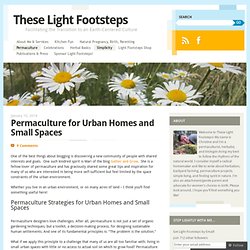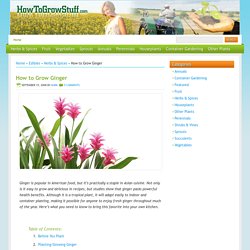

Growing / Planting Guides. Forage / Wild. Vertical and Container Growing. Raising. Fruits and Veggies: Growing info. 40 Inspiring DIY Herb Gardens. If you love to cook you most likely can’t live without fresh herbs.

You can buy them when you need them but it would be much better if you will always have them in pots near by. Grow plants from your groceries, like ginger root and pineapple! 17 Apart: Growing Celery Indoors: Never Buy Celery Again. Remember when we tested and shared how to grow onions indefinitely last week?

Well, at the same time, we've been testing out another little indoor gardening project first gleaned from Pinterest that we're excited to share the successes of today — regrowing celery from it's base. We've figured out how to literally re-grow organic celery from the base of the bunch we bought from the store a couple weeks ago. I swear, we must have been living under a rock all these years or just not be that resourceful when it comes to food, but we're having more fun learning all these new little tips and tricks as we dive deeper into trying to grow more of our own food. This project is almost as simple as the onion growing project — simply chop the celery stalks from the base of the celery you bought from the store and use as you normally would. In our case, we had a particular homemade bean dip that needed sampling! Update 2: Here's how we are looking at almost 3-4 weeks of growth:
What Everybody Ought to Know About Medicinal Uses Of These 22 Common Spices. Guide to Growing Vegetables. Some general considerations for growing vegetables: Sowing Tips When sowing seeds, a good general rule of thumb is to sow to a depth of approximately twice the thickness of the seed.

Some smaller seeds require light to germinate and should not be sown too deep; otherwise they may never germinate or break through the surface of the soil. Conversely, large seeds planted too shallow may not develop properly. Keep seeds well-moistened while awaiting germination and check regularly. Select a light-weight, well-drained medium for sowing to ensure good seed to soil contact. Growing Tips Most vegetables will produce better results if sown and grown in a soil-medium that is well-drained, rich in organic matter (fertile), and fairly lightweight. Most vegetables will prefer good quantities of natural, direct sunlight daily.
Harvesting and Seed Saving Many vegetables will be harvested in the fall, especially if grown in lower hardiness zones. How to grow herbs indoors this winter. 10 Mosquitoes Controlling Plants for Home. Mosquitoes are among the biggest nuisance of monsoon that ruins the outdoor fun.

Bites of mosquitoes are extremely itchy as well as spread diseases such as malaria. People use mosquito coils, mosquito repellent creams, electronic mosquito repellents and herbal mosquito lotions to keep mosquitoes at a bay. Top 5 Herbs To Grow For Cooking & Medicinal Use. If you're new here, you may want to sign up for FREE weekly updates delivered to your inbox featuring Real Food recipes, nutrition & health articles, and special discounts or promotions.

P.S. This post may contain affiliate links to products or services I use, enjoy, or recommend. By making purchases through these links, you are supporting the companies or products I believe in, and you're supporting Food Renegade. Thank you! The following is a guest-post by Brenda Scott of The Well-Fed Homestead. Permaculture for Urban Homes and Small Spaces. One of the best things about blogging is discovering a new community of people with shared interests and goals.

One such kindred spirit is Mari of the blog Gather and Grow. She is a fellow lover of permaculture and has graciously shared some great tips and inspiration for many of us who are interested in being more self-sufficient but feel limited by the space constraints of the urban environment. Ngo Family Farm: garlic tea for the garden. I recently noticed some little bugs attacking my house plants and indoor citrus trees, so I whipped up a batch of garlic tea to help me combat the problem.

I forget where I first learned about this, but I've been using it for years now to help with pest control on plants both inside and out. It's best used as a preventative measure or when you catch an infestation in the early stages, but it's a simple and organic way to keep plants from being bad bug dinner. How to make Garlic Tea: 1. Blend up 3 or 4 garlic cloves (leave the paper skins on) with about 1/2 Cup of water. What to Grow in the Shady Bit. I’m asked on a regular basis what to grow in the shady part of a vegetable plot so I thought it was about time I wrote a post on the topic.

So here goes. Firstly, you’re not alone in wondering what the heck to grow in the shady bit of the garden. Most of the vegetable books talk about giving plants an ‘open site’ ‘in full sun’. Which is totally possible on an allotment but is virtually impossible in your own garden at home. There are usually walls, fences, trees, and buildings to contend with making it inevitable that there will always be a ‘shady bit’ How to Grow Ginger. Ginger is popular in American food, but it’s practically a staple in Asian cuisine.

Not only is it easy to grow and delicious in recipes, but studies show that ginger packs powerful health benefits. 8 Most Profitable Plants To Grow. Ginseng Roots Can Bring Up to $400 a Pound Growing plants for profit is a great way to turn your gardening skills into serious cash.

While most of us immediately think of tomatoes or salad greens, the most profitable plants are specialty crops that are not always found in a home vegetable garden. Many specialty crops can bring as much as $90,000 per acre, and are quite easy to grow. Best of all, most specialty crops can be grown without a full-time commitment.